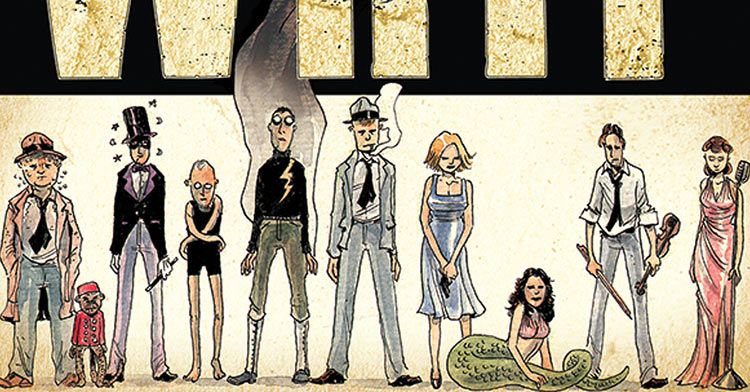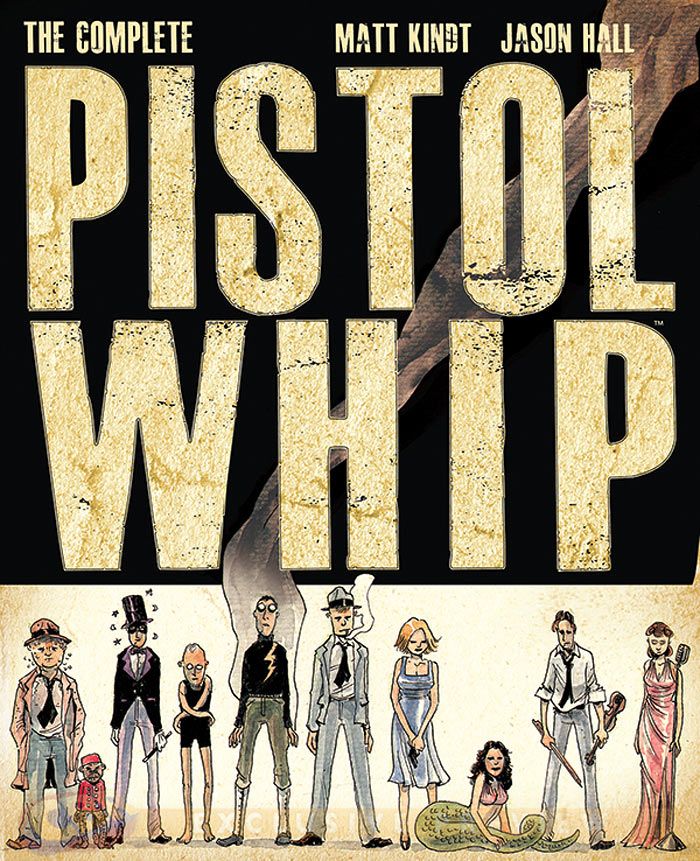In 2001, Matt Kindt's first original graphic novel hit comic shop shelves. Originally printed by Top Shelf, "Pistolwhip" was a collaboration with Jason Hall that took the central conceit of bringing radio serials to a graphic format, featuring the intersecting stories of a bellhop's struggle, an expatriate musician, a paranoid woman and the mysterious figure that links them all. Nominated for a Harvey Award in 2002, "Pistolwhip" is getting a second life at Dark Horse Comics in "The Complete Pistolwhip," an edition that collects the entirety of the series -- including "Pistolwhip," "Pistolwhip and the Yellow Menace" and "Mephisto and the Empty Box" -- in a single volume.
EXCLUSIVE: Matt Kindt Time Travels with "PastAways"
Kindt spoke with CBR News about the reprint project, and in looking back to the very beginnings of his professional career in comics, we discussed how "Pistolwhip" relates to the rest of his creator-owned work, what it's like to see his old work in color for the first time and more.
CBR News: Matt, "Pistolwhip" was your first graphic novel at Top Shelf. Why do you think it's a good time to release it back into the wild?
Matt Kindt: From the business end, it was out of print, so I wanted to have it in print again. Top Shelf wasn't really able to get it on their schedule, and Dark Horse basically wants to publish everything I do. [Laughs] From a business standpoint, it made sense, and I just like the idea of all my books being in one place. If you want anything by me, you can go to Dark Horse and you can get the whole library.
Also, it's been a while -- that was my first book, and when it came out, nobody knew who I was. There were years where I would go to conventions and try to hand-sell that book, and a lot of people just weren't aware of it. People are just discovering me now, with other, bigger stuff that I've been doing.
It's nice to have that book come out and I looked at it again -- it still holds up! It was my first book and I was still learning a lot of things, trying to figure out what I was doing and what I wanted to do. I like that book because I can see the seeds of things that I would do later. Hopefully, that's fun for people that read it.
"Pistolwhip" does seem to have a lot in common with your later work -- it's got that crime noir feel, with a lot of converging stories. How do you think your work on the book informed the rest of your career?
The big breakthrough I made with that book was actually something that happened with based on stuff I had done before. I had done probably 300 pages of mini-comics before "Pistolwhip," and all of it was autobiographical or super pretentious -- what is the meaning of art, and all that sort of thing, the horrible day jobs I had -- those are the kind of comics I was doing. At the time, I was reading "Hate" and pretty much everything Fantagraphics had. I was sort of sick of superheroes. When I was done doing a bunch of those comics and getting them out of my system, I realized it really wasn't fun. If you have a horrible day job, the last thing I felt like doing was drawing that horrible day job. What's the point of that? I realized I could still tell stories that dealt with the meaning of art and horrible day jobs, but with a candy coating -- a detective, noir elements, circus freaks -- certain things to make it more visually appealing. It would make me more interested. It's a lot more interesting to draw pirates than it is to draw some guys treating you horribly at work.
That was the breakthrough with that book. I've done it ever since, where the genre trappings are what make it fun to draw and fun to read. All the meaning and all the deeper layers can still be in there, they're just presented in a more entertaining way. I think what I learned from "Pistolwhip" is how to do that.
The collection will also feature colored versions of the Pistolwhip stories for the first time. What was the experience like going back through your early art and seeing it colored?
It was interesting, because I was teaching a comic book class years ago and one of the students in there, Marie Enger -- she was really good, and when she graduated, this stuff started coming up. I was like, "I would really like to do it in color, but I don't have the time to do it." The nature of the art and everything made it so that it had to be colored digitally, which isn't something I'm a big fan of. But the student I had was really good, and she's really good with the digital stuff. I felt comfortable handing it off to her, so she colored the entire thing. It was weird on two levels: One, seeing my old work in color, and two, not being the one doing it. It was a little bit of a letting go process.
But it's cool. I have a studio now, that she shares with me and Brian Hurtt. Every day she's coloring another page and I'll kind of look at it. At first, I didn't think I would like it, because I definitely do the art in black and white, designing it that way. Now that I see the color and the way it's being handled, it's subdued and faded and fits the period -- it just looks super cool. I don't want to see it in black and white again. [Laughs]
The original "Pistolwhip" was a lot like an illustrated radio play -- going so far as to design its cover as an old-timey radio. What really spoke to you and Jason about radio plays, and what do you think made the format a good fit for a graphic novel?
At the time, I was really being influenced by these old radio shows. I was driving to work, and my car was an old '59 T-bird. All I had was a tube radio, so it took a while to warm up. In the morning, I could listen to the news or I could listen to this show called "The Breakfast Cereal." They would play an episode of "The Shadow" or "The Green Hornet" or something like that -- you would get a little piece staring on Monday, and you would get the whole story by Friday. Every day, I would listen to that on the way in. It was kind of fun. The stories were a little goofy and the acting was fun. I liked the serialized nature -- I think that's where "Pistolwhip" came from, the harkening back to that time and the fun nature of the radio serial, but putting a twist on it and doing it visually.
For those who have enjoyed your work on "MIND MGMT," what do you think will appeal to them in "Pistolwhip?"
There are sly little nods to stuff in "Pistolwhip" that appear in everything. I can't remember the specific instances, but I always try to slip something in there. In my mind, I feel like every book I've done exists in the same universe, so everything can exist together and does inhabit the same world. In a way, "Pistolwhip" -- while not directly tied to any of the other books -- does take place in that same reality. I guess when I go back and look and read it, I can see early influences and see things that are still resonating in my stuff today. One of my favorite movies is "Touch of Evil," and there's a character -- a big, sweaty guy in a hat in "Pistolwhip" based on Orson Welles in "Touch of Evil" -- and literally just this month, there's a character that pops up in "MIND MGMT" based on the Gypsy fortune teller, Marlene Dietrich's character, in "Touch of Evil." There are parallels that are still there -- I can't shake some of the stuff that I just love.
I swear, that sweaty guy in "Pistolwhip" has appeared in probably everything I've done, in some way or another.
I'm sure there are quite a few people who have already read "Pistolwhip." Other than colors, what else will be included in the book in terms of new content?
I don't know there's anything necessarily new. It's all going to be put together in one piece. The "Pistolwhip" book, the sequel "The Yellow Menace" and "Mephisto," which was a 24-page story that ties into the books, will all be in there, along with a ton of promo stuff. There's an 8-page short story I did for a Dark Horse anthology and a couple pages of another short story that appeared who knows where, the original pitch for the book and a lot of the promo stuff I've done over the years, like tobacco cards and fake cigarette ads, a little mini-comic that explains what the book is about -- all that stuff is going to be in there. It's a one-stop shop for everything that's ever had the "Pistolwhip" name on it.


